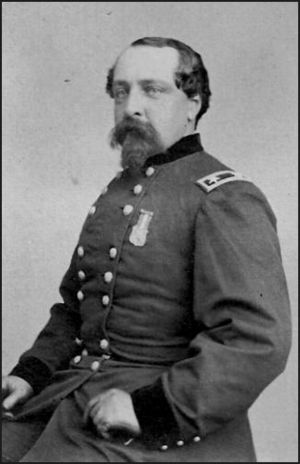Edward Ferrero facts for kids
Quick facts for kids
Edward Ferrero
|
|
|---|---|

Edward Ferrero
|
|
| Born | January 18, 1831 Granada, Spain |
| Died | December 11, 1899 (aged 68) New York City, New York |
| Place of burial | |
| Allegiance | United States of America Union |
| Service/ |
United States Army Union Army |
| Years of service | 1861–1865 |
| Rank | |
| Battles/wars | American Civil War |
Edward Ferrero (born January 18, 1831 – died December 11, 1899) was a famous dance teacher and ballroom owner in the United States. He also became a general in the Union Army during the American Civil War. He is often remembered for his actions during the Battle of the Crater in July 1864, where he faced criticism for not being with his troops.
Contents
Who Was Edward Ferrero?
Edward Ferrero was born in Granada, Spain. His parents were from Italy and had just arrived in Spain when he was born. About a year later, his family moved to the United States. They settled in New York City.
A Family of Dancers
Ferrero's father was a well-known dancer. He was also a friend of the famous revolutionary General Giuseppe Garibaldi. Soon after moving to New York, Ferrero's father opened a dance academy. When his father retired, Edward took over the business.
Edward Ferrero taught dance to many wealthy and important people in New York society. He even created new dances that became popular across the country. He became known as one of America's top dance experts. He also worked part-time teaching dance at the United States Military Academy at West Point. In 1859, he wrote a book called The Art of Dancing.
Early Military Interests
Ferrero was interested in military life from a young age. This interest came from his connection to Garibaldi and his uncle, Colonel Lewis Ferrero. His uncle had served in the Crimean War. Edward Ferrero became a lieutenant colonel in the 11th New York Militia Regiment. He served in this group for six years. Because of his skills in teaching and choreography, his troops became known for their excellent parade drills.
Ferrero in the Civil War
When the Civil War began in 1861, Ferrero helped raise a new regiment. He paid for much of it himself. This group was called the 51st New York Volunteer Infantry Regiment. He became its first colonel and trained the soldiers.
Early Battles and Promotions
Ferrero led a group of three regiments in Maj. Gen. Ambrose Burnside's trip to Roanoke Island. His regiment captured the first fortified Confederate position taken in the war. He also led a group at New Bern.
In the summer of 1862, his group moved to Virginia. He served under Maj. Gen. John Pope during the Northern Virginia campaign. This included the Second Battle of Bull Run. In September, he fought at the battles of South Mountain and Antietam. His group was part of the Union IX Corps. They bravely stormed Burnside's Bridge at Antietam. For his courage at Antietam, Ferrero was promoted to brigadier general on September 19, 1862. His first battle as a general was at Fredericksburg.
Moving West and Back East
In early 1863, Ferrero and the IX Corps moved to the Western Theater. He led his group well during the Siege of Vicksburg. Later, he commanded a division during the Knoxville campaign. He was in charge of the defenses at Fort Sanders.
In 1864, he moved back east with his corps. He served in the Siege of Petersburg. There, he commanded a division of black troops.
The Battle of the Crater
His men were part of the difficult charge on the Crater on July 30. They suffered many losses while supporting another division's attack. Ferrero received criticism for his actions during this battle. A court of inquiry later said he was "being in a bomb-proof habitually, where he could not see the operation of his troops." This meant he was not where he could properly lead his soldiers.
On December 2, 1864, Ferrero was given the honorary rank of major general. This was for his "bravery and meritorious services." He continued to serve through the Appomattox Campaign in early 1865.
Life After the War
Ferrero left the army on August 24, 1865. He returned home to New York City. He decided not to reopen his old dance academy. Instead, he leased a new building and turned it into a famous ballroom. It was called Apollo Hall. In 1872, he ended his lease, and the building became a theater.
Ferrero then leased the ballroom of Tammany Hall for his academy. He became active in Democratic politics. He never ran for office himself. He was also involved in groups for veterans, like the Grand Army of the Republic. He also joined the Freemasons. He published another popular book called The History of Dancing.
In January 1889, he leased the Lenox Lyceum. He continued to be one of the country's top dance instructors for another ten years. He retired in May 1899 because he became ill. He passed away later that year.
Edward Ferrero died in New York City. He is buried in Green-Wood Cemetery, Brooklyn.
Ferrero's Books

